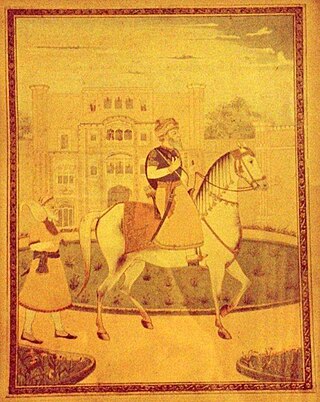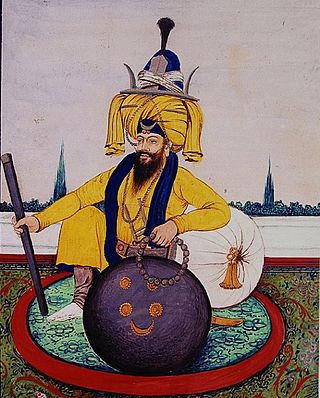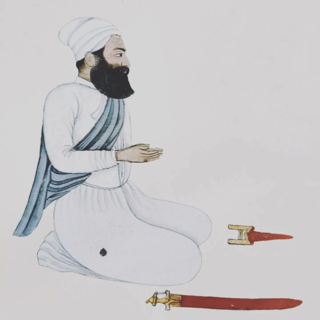| Battle of Talwara | |||||||
|---|---|---|---|---|---|---|---|
| Part of Hill States-Sikh Wars | |||||||
| |||||||
| Belligerents | |||||||
| | | ||||||
| Commanders and leaders | |||||||
| | | ||||||
The Battle of Talwara was fought in 1770 by the Sikh forces led by Jassa Singh Ramgarhia and the Kangra forces led by Raja Ghamand Chand.
| Battle of Talwara | |||||||
|---|---|---|---|---|---|---|---|
| Part of Hill States-Sikh Wars | |||||||
| |||||||
| Belligerents | |||||||
| | | ||||||
| Commanders and leaders | |||||||
| | | ||||||
The Battle of Talwara was fought in 1770 by the Sikh forces led by Jassa Singh Ramgarhia and the Kangra forces led by Raja Ghamand Chand.
The Sikhs and the Hill States were big enemies during the time of Guru Gobind Singh. [1] They had fought over the disputed city of Anandpur Sahib until the Treaty of Anandpur which stated that if the Guru leaves Anandpur, he will never have to fight the hill states. [2] [3] The Guru agreed, and Anandpur was officially a Hill State city until Banda Singh Bahadur defeated Kahlur and annexed the land, including Anandpur. [4] [5] During the period of Dal Khalsa (Sikh Army), the Sikhs maintained close relations with the Hill States. Jassa Singh Ahluwalia once assisted the Hill States in order to defeat the Mughals. [6] However, no Sikh Sardar attacked the Hill States until Jassa Singh Ramgarhia in 1770. [7] [8]
He attacked the Hill States first alone and then with Jai Singh Kanhaiya, in which they were repulsed. However, in the third time, a pitched battle was fought at Talwara in which he was successful. [9] This battle made states like Kangra, Nurpur and Chamba. [10] Kangra alone gave a tribute of 200,000 rupees to Jassa Singh Ramgarhia. [11]
To have control over the hills, the Sardar build a fort at Talwara in which his brother Mali Singh along with 4,000 horsemen stayed in. [9]

Dal Khalsa was the name of the combined military forces of 11 Sikh misls that operated in the 18th century (1748–1799) in the Punjab region. It was established by Nawab Kapur Singh in late 1740s.
Guru Nanak founded the Sikh religion in the Punjab region of the northern part of the Indian subcontinent in the 15th century and opposed many traditional practices like fasting, janeu, idolatry, caste system, ascetism, economic materialism, and gender discrimination.

Jassa Singh Ramgarhia (1723–1803) was a prominent Sikh leader during the period of the Sikh Confederacy. He was the founder of the Ramgarhia Misl.

Sultan-ul-Qaum Sardar Jassa Singh Ahluwalia was a Sikh leader during the period of the Sikh Confederacy, being the Supreme Leader of the Dal Khalsa. He was also Misldar of the Ahluwalia Misl. This period was an interlude, lasting roughly from the time of the death of Banda Bahadur in 1716 to the founding of the Sikh Empire in 1801. He founded the Kapurthala State in 1772.

Baghel Singh was a Military general in the Punjab region in the northern part of the Indian subcontinent in the 18th century. He rose to prominence in the area around Sutlej and Yamuna. Singh joined the Singh Krora Misl, one of the misls during Sikh Confederacy. In 1765, Singh became the leader of the misl.

The second siege of Anandpur, also known as the second battle of Anandpur (1704), was a siege at Anandpur, between Sikhs and the Mughal governors, dispatched by Aurangzeb, Wazir Khan, Dilwaar Kahn and Zaberdast Khan, and aided by the vassal Rajas of the Sivalik Hills which lasted from May 1704 to 19 December 1704.
Battle of Anandpur can refer to:

Binod Singh, a Trehan Khatri and a descendant of Guru Angad, was an army man and disciple of Guru Gobind Singh and was among few Sikhs who accompanied him to Nanded in 1706. In Budha Dal Chronicles, Guru Gobind Singh made Baba Binod Singh the head of the Khalsa.

Baba Darbara Singh, also known as Diwan Darbara Singh, was second Jathedar of Budha Dal and third leader of the Akal Takht. He should not be confused with other Darbara Singh of Sirhind who fought in the Battle of Anandpur.
The Battle of Nirmohgarh was fought between Sikhs and the Mughal Empire in 1702.

Ramgarhia Misl was a sovereign state (misl) in the Sikh Confederacy of Punjab region in present-day India and Pakistan. The misl's name is derived from Qila Ramgarh, a place located in Ramsar, near Amritsar, which was fortified and redesigned by Ramgarhia Misl chief Jassa Singh Ramgarhia. The Ramgarhia Misl was one of the twelve major Sikh misls, and held land near Amritsar.
The first siege of Anandpur was a thirty-five-day-long siege at Anandpur led by the Rajas of the Sivalik Hills and the Gujar and Ranghar tribesmen against the armies of the Sikh under Guru Gobind Singh.

The Battle of Delhi was fought between Khalsa Sikhs and the Mughal Empire in 1783.
The Battle of Guler was fought between forces led by Sikh Guru Gobind Singh and Mughal forces, aided by the Rajas of the Sivalik Hills.
The Battle of Anandpur was fought by the Sikh forces led by Guru Gobind Singh and the Kahlur forces led by Bhim Chand (Kahlur). This was also the first battle fought by Guru Gobind Singh.

The Hill States–Sikh wars, also known as the Sikh–Pahari Raja wars, was a set of battles and conflicts fought by the Sikhs and the rajas (kings) of the Hill States located in the Sivalik Hills.

Alam Singh Nachna, also called Alim Singh, was a warrior in the army of Guru Gobind Singh, and was a Rajput turned Sikh. Sarup Das Bhalla of Mahima Prakash describes him as one of Guru Gobind Singh's constant and closest companions. He is also known for killing a lion single handedly.
The Battle of Anandpur (1685) was fought between the Sikhs and an allied force of rajas of the Hill States of the Sivalik range, specifically Kahlur, Kangra, and Guler.
The Battle of Bilaspur was fought in 1711 by Sikh forces led by Banda Singh Bahadur and the rulers of the Sivalik Hills led by Raja Ajmer Chand of Princely State of Kahlur (Bilaspur).